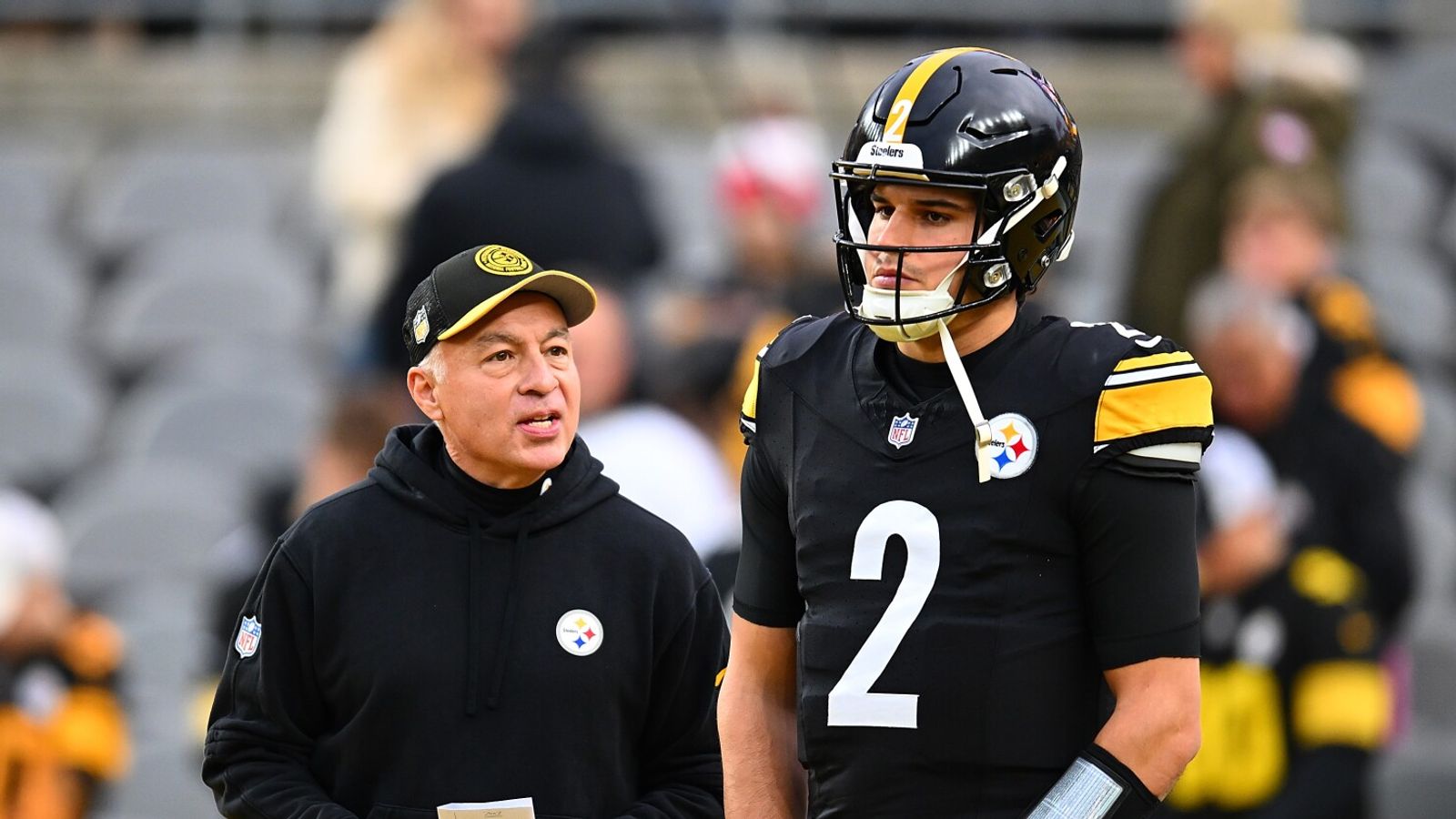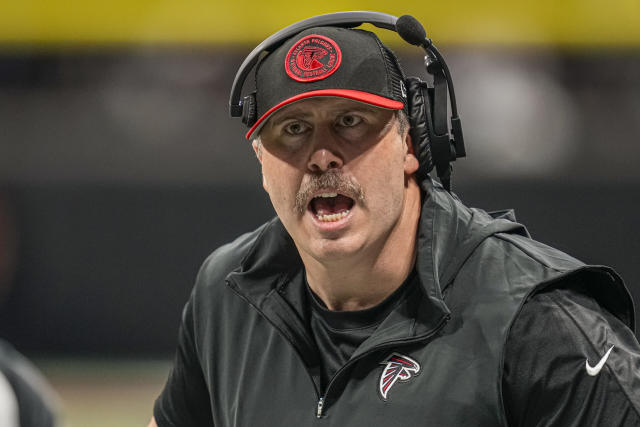
Furthermore, the message is very apparent. You had better be ready to halt the run if you play the Steelers.
Throughout his five years as an offensive play caller, Smith’s teams have demonstrated a Smith’s to run the ball effectively.
That seems like a good fit with the Steelers’ current setup.
“I believe that we have two excellent running backs in Jaylen Warren and Najee Harris,” stated Steelers president Art Rooney II earlier this week. “They, along with an improving offensive line, can be the foundation of success going forward.”
In terms of overall rushing yards, Smith’s teams have placed second once and third twice. In terms of rushing yards per game during the previous campaign, the Falcons ranked tenth in the NFL.
Maybe that’s a result of working for the head coaches he has endured.
And everyone should be familiar with those names, particularly Steelers supporters.
In 2007 and 2008, he worked as a defensive quality control coach for Hall of Fame coach Joe Gibbs before moving on to Jim Zorn.
With more than 1,200 rushing yards in 2007 and almost 1,500 yards in 2008, Clinton Portis led that Washington club.
Following that, Smith’s NFL career has a distinctly Steelers flavor to it, having worked with former players Mike Vrabel and assistant coaches Mike Munchak, Ken Whisenhunt, and Mike Mularkey.
In 2007 and 2008, he worked as a defensive quality control coach for Hall of Fame coach Joe Gibbs before moving on to Jim Zorn.
With more than 1,200 rushing yards in 2007 and almost 1,500 yards in 2008, Clinton Portis led that Washington club.
Following that, Smith’s NFL career has a distinctly Steelers flavor to it, having worked with former players Mike Vrabel and assistant coaches Mike Munchak, Ken Whisenhunt, and Mike Mularkey.
Smith came up through the Tennessee Titans organization, joining the team in 2011 under Munchak as a defensive quality control coach. He shifted over to the offensive side of things in 2012, again as quality control coach before becoming offensive line/tight ends assistant in 2013.
Munchak was fired in 2013 and replaced by Whisenhunt. Whisenhunt kept Smith as assistant tight ends coach, and when he was replaced in 2015 by Mularkey, Mularkey elevated Smith to tight ends coach.
Smith retained that job following Mularkey’s departure after the 2017 season, getting elevated to offensive coordinator by Vrabel in 2019.Smith replaced Matt LeFleur as the head coach of the Atlanta Falcons after just two seasons as Vrabel’s offensive coordinator. After serving as Tennessee’s offensive coordinator for just one season, LeFleur was brought on board by the Packers as head coach.
In 2018 under LeFleur, Derrick Henry rushed for 1,059 yards, his first 1,000-yard season. In 2019 under Smith’s direction, Henry rushed for 1,540 yards. Then, in 2020, he had 2,027 rushing yards.
Tyler Allgier rushed for over 1,000 yards in 2022 for the Falcons under Smith, while rookie Bijan Robinson had more than 1,400 total yards for the Falcons in 2023.
But it’s not all about running the ball. Smith’s system is quarterback friendly, with heavy usage of play-action.Ryan Tannehill’s career was revived by Smith during his tenure with the Titans. In exchange for the Dolphins’ fourth and seventh round selections in 2019, Tennessee obtained Tannehill and a sixth-round pick from Miami. Though Marcus Mariota was supposed to be his backup, he outperformed him in Smith’s highly play-action-oriented schemes, and he ended up starting ten games, finishing 7-3, with 22 touchdown passes against just six interceptions. The Titans finished 11-5 in 2020 with quarterback Ryan Tannehill tossing 33 touchdown passes against only seven interceptions while Henry was rushing for 2,000 yards.
Play-action usage by the Steelers has long lagged behind the rest of the NFL, but when it has been used, quarterback Kenny Pickett has performed admirably. Play-action has allowed Pickett to complete 67.6 of his passes, as opposed to 61.6 when it hasn’t. Additionally, he has an 85.7 passer rating. His passer rating is 77.6 when play-action is not used.
In Smith’s two seasons as coordinator, the Titans finished 21st and 23rd in overall passing yards, but they also finished ninth in passing touchdowns. Also, they scored 10 or more points in each of the two seasons.
Play-action usage by the Steelers has long lagged behind the rest of the NFL, but when it has been used, quarterback Kenny Pickett has performed admirably. Play-action has allowed Pickett to complete 67.6 of his passes, as opposed to 61.6 when it hasn’t. Additionally, he has an 85.7 passer rating. Their general effectiveness in the red zone has contributed significantly to his play-action pass efficiency when he hasn’t used it. In 2019 the Titans scored a touchdown 94.1 percent of the time when they were in a goal-to-go position. They reached 88 percent in 2020. In those two years, they were the NFL’s leaders. In goal-to-go scenarios from the previous season, the Steelers ranked 20th, scoring a touchdown 66.7 percent of the time.
With Smith in charge, the Titans additionally
Co-host of “SNR Drive” on Steelers Nation Radio is Dale Lolley. Here’s where you may subscribe to the podcast: iHeart Podcast | Apple Podcast
Additionally, Smith’s offensive strategies differ significantly from those the Steelers have employed recently.
Using three wide receivers, one tight end, and one running back as their primary package, the Steelers have been among the league’s heaviest 11-person teams for the greater part of the last ten years. Performing 73.1 percent of their snaps in that package in 2023 was part of that.
In 2023, Atlanta employed 11 players for only 15% of the time, the lowest percentage in the NFL.
The Falcons used 12 players—two wide receivers, one tight end, and two running backs—more than any other team. Usually, a fullback and a runner were used together. Atlanta topped the NFL in playing with 12 players on the field almost 42% of the time.
Regarding the amount of time the Falcons used two- and three-tight end groupings, they were among the top 10 teams in the NFL.







